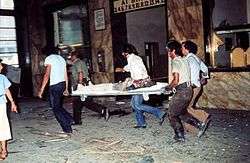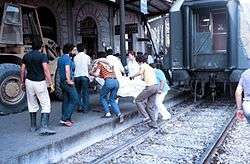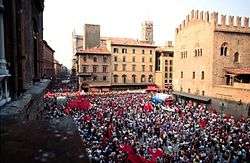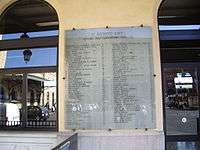Bologna massacre
| Bologna massacre | |
|---|---|
 Rescue teams making their way through the rubble. | |
| Location | Bologna Central Station |
| Date |
2 August 1980 10:25 (UTC+1) |
Attack type | Bomb attack |
| Deaths | 85 |
Non-fatal injuries | 200+ |
| Perpetrators |
Luigi Ciavardini, Valerio Fioravanti and Francesca Mambro (members of the Nuclei Armati Rivoluzionari) |
The Bologna massacre (Italian: strage di Bologna) was a terrorist bombing of the Central Station at Bologna, Italy, on the morning of 2 August 1980, which killed 85 people and wounded more than 200. The attack was carried by the neo-fascist terrorist organization Nuclei Armati Rivoluzionari (Armed Revolutionary Nuclei), which always denied any involvement; other theories have been proposed, especially in correlation with the strategy of tension. The bombing is the fourth deadliest terrorist attack in Western Europe behind the Nice attack in 2016, Paris attacks in November 2015, and the Madrid train bombings in 2004.
Bombing


At 10:25 a.m., a time-bomb contained in an unattended suitcase detonated inside an air-conditioned waiting room, which, the month being August (and with air conditioning being uncommon in Italy at the time), was crammed full of people. The explosion destroyed most of the main building and hit the Ancona–Chiasso train that was waiting at the first platform. The blast was heard for miles. The roof of the waiting room collapsed onto the passengers, which greatly increased the total number killed in the terrorist attack.[1]
On that summer Saturday the station was full of tourists and the city was unprepared for such a massive incident. Many citizens and travelers provided first aid to victims and helped to extract people buried under the rubble. Given the large number of casualties, since the ambulances and emergency vehicles were not sufficient for the transport of the injured to the city's hospitals, firefighters also employed buses, in particular the line 37, private cars and taxis. In order to provide care to the victims of the attack, doctors and hospital staff returned from vacation, as well as departments, closed for summer holidays, were reopened to allow the admission of all patients.
In the following days the central square of Bologna, Piazza Maggiore, hosted large-scale demonstrations of indignation and protest among the population, in which were not spared harsh criticism and protests addressed to government representatives, who attended the funerals of the victims celebrated in the Basilica San Petronio on 6 August. The only applause was reserved for the Italian President Sandro Pertini, who arrived by helicopter in Bologna at 17.30 on the day of the massacre, and said in tears in front of reporters: "I have no words, we are facing the most criminal enterprise that has ever taken place in Italy."[2]
The bus no. 37, together with the clock stopped at 10:25, remained a symbol of the massacre. The attack was recorded as the worst atrocity in Italy since World War II.[3]
Investigations
The next day, police investigators found metal fragments and scraps of plastics near the source of the explosion.[4]
The bomb was later found to be composed of 23 kg of explosive, a mixture of 5 kg of TNT and Composition B, improved from 18 kg of T4 (nitroglycerin for civil use).[5]
The Italian Government led by Christian Democrat Prime Minister Francesco Cossiga first assumed the explosion to have been caused by an accident (the explosion of an old boiler located in the basement of the station). Nevertheless, soon the evidence gathered on site of the explosion made it clear that the attack constituted an act of terrorism. L'Unità, the newspaper of the Italian Communist Party (PCI) on 3 August already attributed responsibility for the attack to neo-fascists. Later, in a special session to the Senate, Cossiga supported the theory that neofascists were behind the attack, "unlike leftist terrorism, which strikes at the heart of the state through its representatives, black terrorism prefers the massacre because it promotes panic and impulsive reactions."[6][7]
Disinformation and false leads
Almost immediately after the bombing, the press agency Ansa received a telephone call from someone purporting to represent NAR claiming responsibility. The call later proved to be fake, and to have originated from the Florence office of SISMI, the Italian Military Secret Service. Federigo Manucci Benincasa, director of the Florence branch of SISMI, would later be charged with obstruction of justice.
In September 1980 a "Lebanese connection" was manufactured, involving Al Fatah, Phalangists, Italian radicals and Swiss journalists tied to the Italian intelligence community, who supplied investigators with fake notes, memos, and reports.[8] This was followed by a "KGB connection" fostered by head of Intelligence General Giuseppe Santovito, a member of P2, and Francesco Pazienza.
Generals Pietro Musumeci, a member of P2, and Giuseppe Belmonte of SISMI had a police sergeant put a suitcase full of explosives, of the same type that blew up the station, on a train in Bologna. The suitcase also contained personal items of two right-wing extremists, a Frenchman and a German. Musumeci also produced a phony dossier, called "Terror on trains". General Musumeci was charged with falsifying evidence in order to incriminate Roberto Fiore and Gabriele Adinolfi, two leaders of Terza Posizione who had fled to London.[9] Both Terza Posizione leaders claimed that Musumeci was trying to divert attention from Licio Gelli, (head of the "masonic" lodge P2).[9]
Licio Gelli and Francesco Pazienza were convicted of obstructing the investigation, as were Generals Pietro Musumeci, and Giuseppe Belmonte of SISMI.
Prosecution and trial
The attack has been attributed to the NAR (Nuclei Armati Rivoluzionari), a neo-fascist terrorist organization. A long and controversial court case began after the bombing. Francesca Mambro and Giuseppe Fioravanti were sentenced to life imprisonment.
In April 2007 the Supreme Court confirmed the conviction of Luigi Ciavardini, a NAR member associated closely with close ties to Terza Posizione. Ciavardini received a 30-year prison sentence for his role in the attack.[10] Ciavardini had been arrested following the armed robbery of the Banca Unicredito di Roma on 15 September 2005.[11][12] Ciavardini was also charged with the assassination of Francesco Evangelista on 28 May 1980, and the assassination of Judge Mario Amato on 23 June 1980.[12]
On 26 August 1980, the prosecutor of Bologna issued twenty-eight arrest warrants against far right militants of the NAR and Terza Posizione. Among those arrested were: Massimo Morsello (future founders of Forza Nuova), Francesca Mambro, Aldo Semerari, Maurizio Neri and Fascist militant Paolo Signorelli. They were interrogated in Ferrara, Rome, Padua and Parma. All were released from prison in 1981.
Main stages of the trial:
- Bologna, 9 March 1987: first trial.
- Accused of murder: Massimiliano Fachini, Valerio Fioravanti, Francesca Mambro, Sergio Picciafuoco, Roberto Rinani and Paolo Signorelli.
- Accused of armed gang: Gilberto Cavallini, Massimiliano Fachini, Valerio Fioravanti, Egidio Giuliani, Marcello Iannilli, Francesca Mambro, Giovanni Melioli, Sergio Picciafuoco, Roberto Raho, Roberto Rinani and Paolo Signorelli.
- Accused of subversive association: Marco Ballan, Giuseppe Belmonte, Fabio De Felice, Stefano Delle Chiaie, Massimiliano Fachini, Licio Gelli, Maurizio Giorgi, Pietro Musumeci, Francesco Pazienza, Paolo Signorelli and Adriano Tilgher.
- Accused of defamation to ensure impunity for massacre's perpetrators: Giuseppe Belmonte, Licio Gelli, Pietro Musumeci and Francesco Pazienza.[13]
- 11 July 1988, judgment.
- Life imprisonment for the crime of murder: Massimiliano Fachini, Valerio Fioravanti, Francesca Mambro and Sergio Picciafuoco. Acquitted: Roberto Rinani and Paolo Signorelli.
- Convicted of armed gang: Gilberto Cavallini, Massimiliano Fachini, Valerio Fioravanti, Egidio Giuliani, Francesca Mambro, Sergio Picciafuoco, Roberto Rinani and Paolo Signorelli. Acquitted: Marcello Iannilli, Giovanni Melioli and Roberto Raho.
- Acquitted of subversive association: Marco Ballan, Giuseppe Belmonte, Fabio De Felice, Stefano Delle Chiaie, Massimiliano Fachini, Licio Gelli, Maurizio Giorgi, Pietro Musumeci, Francesco Pazienza, Paolo Signorelli and Adriano Tilgher.
- Convicted of defamation to ensure impunity for massacre's perpetrators: Giuseppe Belmonte, Licio Gelli, Pietro Musumeci and Francesco Pazienza.[13]
- 25 October 1989: starts the appeal process.[13]
- 18 July 1990, judgment on appeals.
- Acquitted of murder: Massimiliano Fachini, Valerio Fioravanti, Francesca Mambro, Sergio Picciafuoco, Roberto Rinani and Paolo Signorelli.
- Convicted of armed gang: Gilberto Cavallini, Valerio Fioravanti, Francesca Mambro and Egidio Giuliani.
- Convicted of defamation: Giuseppe Belmonte and Pietro Musumeci (acquitted of subversive association). Acquitted the other defendants.[13]
On 12 February 1992 the United Sections of the Criminal Court of Cassation acquitted Roberto Rinani and Paolo Signorelli from the charge of murder (Signorelli is also acquitted for armed gang and subversive association). It also acquitted a number of other defendants od various charges, cancelled the judgment and ordered a new trial. The Court of Cassation declared the appeal process must be redone, because the sentences were deemed "illogical, incoherent, not assessing proofs and evidence in good terms, not taking into account the facts preceding and following the event, unmotivated or poorly motivated, in some parts the judges supporting unlikely arguments that not even the defense had argued".
- 11 October 1993: starts the new appeal trial.
- Accused of murder: Massimiliano Fachini, Valerio Fioravanti, Francesca Mambro and Sergio Picciafuoco.
- Accused of armed gang: Gilberto Cavallini, Massimiliano Fachini, Egidio Giuliani, Valerio Fioravanti, Francesca Mambro, Sergio Picciafuoco and Roberto Rinani.
- Accused of defamation to ensure impunity for massacre's perpetrators: Giuseppe Belmonte, Licio Gelli, Pietro Musumeci and Francesco Pazienza.
- 16 May 1994, judgment.
- Life imprisonment for the crime of murder: Valerio Fioravanti, Francesca Mambro and Sergio Picciafuoco. Acquitted: Massimiliano Fachini.
- Convicted of armed gang: Gilberto Cavallini, Valerio Fioravanti, Egidio Giuliani, Francesca Mambro and Sergio Picciafuoco. Acquitted: Massimiliano Fachini and Roberto Rinani.
- Convicted of defamation to ensure impunity for massacre's perpetrators: Giuseppe Belmonte, Licio Gelli, Pietro Musumeci and Francesco Pazienza.
- 23 November 1995: the Supreme Court confirmed the sentence, ordering a new trial for Picciafuoco. Confirmation of life imprisonment to the neo-fascists Valerio Fioravanti and Francesca Mambro, members of the Nuclei Armati Rivoluzionari (NAR)—who have always maintained their innocence—for executing the attack. Sentence for investigation diversion to Licio Gelli (headmaster of P2), Francesco Pazienza and to SISMI officers Pietro Musumeci and Giuseppe Belmonte.
- 18 June 1996: the Appeal Court in Florence acquitted Sergio Picciafuoco for not having committed the crime.
- 15 April 1997: the Supreme Court confirmed the sentence.
In April 1998, Francesca Mambro was authorized to leave her prison during the day, and carried out activities against the death penalty in the headquarters of the Radical Party.[14]
In June 2000, Massimo Carminati (NAR member), Ivano Bongiovanni (thug with sympathy for far-right) and Federigo Manucci Benincasa (SISMI officer) were convicted for obstruction. Carminati and Manucci Benincasa were acquitted for lack of evidence in December 2001, while the use of Bongiovanni is declared unreliable (the conviction becomes final).[15] On 30 January 2003, the Court of Cassation finally acquitted Carminati and Manucci Benincasa.
Alternative hypotheses

Due to the protracted legal procedures over the years and the numerous proven false leads, there developed a number of assumptions and divergent political interpretations around to the real perpetrators and masterminds of the attack.
- One hypothesis is that it was a right wing bomb against a famously left-wing city.
- Another theory suggests that officials in the Italian Secret Service were involved along with members of the secret organization known as the P2.[16]
- In an annex published in fascicles in 1994 of the right-wing weekly L'Italia Settimanale, entitled "History of the First Republic" it is given a particular interpretation of the massacre, linked with Ustica massacre (of which it is literally defined bis, a repetition) and then compared to the cases of Enrico Mattei and Aldo Moro. Without disputing the court rulings that have recognized the perpetrators, the text is intended to indicate the masterminds. The text continues with:
Italy since the birth of the First Republic was, as everyone knows, a country with limited sovereignty (...) now, when, for immediate issues ( ...) has – rarely – made choices that have been found contrary to the covenants to which I said, it made, as said in a mafia-political-diplomatic terms, a sgarro, a "bad mistake". And like in the mafia when a kid is wrong he ends up in some concrete pillar or is deprived of a relative (commonly called "cross-revenge"), so it is among states: When any country is wrong, one does not declare war, but it sends a "warning", as a bomb exploding in a square, on a train, a ship, etc. etc.
- Between 1999 and 2006, during the sessions of the "Parliamentary Commission of Inquiry on terrorism in Italy and on the causes of the failure to identify those responsible for the massacres" (XIII legislature, 1996–2001) and then of the "Commission of Inquiry on the Mitrokhin dossier and the activity of the Italian intelligence (XIV legislature, 2001–2006), new elements have emerged on international terrorist networks and the Italian secret services of the former Soviet bloc and major Arab countries like Syria, Lebanon, Libya, South Yemen and Iraq. With this information it was possible to pick up the threads of a plot hidden for 25 years and discover the key points of a secret agreements with the Palestinian leadership (known as lodo Moro) – the background to the arms trafficking between the PFLP and Italy – the threats to the Italian government for the seizure of missiles and the arrest of the PFLP leader in Italy, Abu Saleh Anzeh, in Ortona – the ties of the terrorist Abu Saleh Anzeh with the internationalist Ilich Ramirez Sanchez, alias Carlos – the warning of the Italian antiterrorist secret service three weeks before the massacre, – the failure of the Italian intelligence operations to avoid retaliatory action – the arrive in Italy on 1 August 1980 of Thomas Kram, of a German terrorist group linked to Carlos and the Palestinians, and present in Bologna on the day of the massacre. Faced with this evidence, on 17 November 2005 the Bologna prosecutor opened a case against unknown persons (Dossier 7823/2005 RG).[17]
- According to media reports in 2004, taken up again in 2007[18] Francesco Cossiga, in a letter addressed to Enzo Fragala, leader of the AN section in the Mitrokhin Committee, suggests a Palestinian involvement (at the hands of George Habash's Popular Front for the Liberation of Palestine and the Separat group of Ilich Ramirez Sanchez, known as "Carlos the Jackal") behind the attack.[19] In addition, in 2008 former President Francesco Cossiga gave an interview to BBC in which it reaffirmed its belief that the massacre would not be attributable to black terrorism, but to an "incident" of Palestinian resistance groups operating in Italy. He declares also being convinced of the innocence of Francesca Mambro and Giuseppe Valerio Fioravanti.[20][21] The PFLP has always denied responsibility.[22]
- In 2005, from his cell in Paris, the pro-Palestinian terrorist Ilich Ramirez Sanchez Carlos stated that "the Mitrokhin Committee attempts to falsify history" and that "they were the CIA and the Mossad to hit in Bologna", with the intent to warn and punish Italy for its relations of mutual trust with the PLO, who had secretly pledged not to hit Italy in exchange for some protection.[23]
- Following the 2006 arrest of former Argentine Triple A member Rodolfo Almirón, Spanish lawyer José Angel Pérez Nievas declared that it was "probable that Almirón participated — along with Stefano Delle Chiaie and Augusto Cauchi — in the 1980 bombing in Bologna's train station." But the Argentine Supreme Court refused in 1998 to extradite Canchi to Italy.[24]
- In May 2007, the son of Massimo Sparti (thug linked to the Banda della Magliana and the main accuser of Fioravanti) declares, "my father in the history of the Bologna process has always lied"[25]
- On 19 August 2011 the prosecutor of Bologna placed under investigation two German terrorists, Thomas Kram and Christa Margot Fröhlich, both linked to the group of terrorist Carlos, who would be present in Bologna on the day of the attack, thus following the trail of Palestinian terrorism, never accepted by the president of the family victims Paolo Bolognesi and instead repeatedly revived by Francesco Cossiga.[26]
Legacy

The municipality of Bologna together with the Associazione tra i familiari delle vittime della strage alla stazione di Bologna del 2 agosto 1980 hold an annual international composition competition, which culminates with a concert in the town's main square, Piazza Maggiore annually on 2 August, which is also the day designated as a national memorial day for all terrorist massacres.
The area of the station where the bomb detonated has been reconstructed but, as a memorial of the attack, the original floor tile pierced by the detonation has been left in place and a deep crack closed by a glass panel has been made in the reconstructed main wall. As a further memorial, the station clock that stopped at 10:25 due to the explosion, has been repaired but permanently set at that time.
List of victims and their ages
|
|
|
Victims' association
Relatives of the victims formed an association (Associazione dei familiari delle vittime della strage alla stazione di Bologna del 2 agosto 1980) to raise and maintain civil awareness about the case. The victims' association (Associazione tra i familiari delle vittime della strage alla stazione di Bologna del 2 agosto 1980) was formed on 1 June 1981 in order to "get due justice with possible initiatives", made up initially of 44 people; the number of members later grew to 300 elements.
The association in the years following the massacre remained active, both for the memory of the massacre and to propose initiatives that were added to the investigation. Quarterly, its components are used to go to the court, in order to meet prosecutors and, out of the meeting, even launching a news conference for information on the state of things.
On 6 April 1983, the Association, together with the associations of victims of the massacres of Piazza Fontana, Piazza della Loggia and Italicus train, formed, based in Milan, the Union of Relatives of Victims to Massacres (Unione dei Familiari delle Vittime per Stragi).[27]
See also
| Wikimedia Commons has media related to Neofascist bombing at Bologna (1980). |
- International Composing Competition "2 Agosto"
- Banda della Magliana, a mafia gang with links to the fascist-aligned NAR
- False flag operations
- List of terrorist incidents
- Aerolinee Itavia Flight 870
- History of the Italian Republic
- La notte della Repubblica (TV programme)
- List of massacres in Italy
- Piazza Fontana bombing
- Strategy of tension
- Games of the XXII Olympiad (Moscow)
- Propaganda Due (P2 lodge)
- Carlos the Jackal
- Terrorism in the European Union
References
- ↑ "1980: Bologna blast leaves dozens dead", BBC News
- ↑ La storia d'Italia, Vol. 23, Dagli anni di piombo agli anni 80, Torino, 2005, pag. 587
- ↑ Davies, Peter, Jackson, Paul (2008). The far right in Europe: an encyclopedia. Greenwood World Press, p. 238. ISBN 1846450039
- ↑ "'95 Percent Sure' Station Blast Was Terror Bomb". Associated Press. 3 August 1980.
- ↑ Carlo Lucarelli, Blu notte La strage di Bologna (Italian).
- ↑ "Police search starts for Bologna bombers". The Globe and Mail. 5 August 1980.
- ↑ "Neo-Fascists 'Prefer Massacre'". Reuters. 6 August 1980.
- ↑ Ferraresi, Franco. Threats to Democracy, Princeton University Press, 2012, p. 260,n.53 ISBN 9781400822119
- 1 2 René Monzat, Enquêtes sur la droite extrême, Le Monde-éditions, 1992, p.89
- ↑ "Bologna bomber's 30-year jail term confirmed". Associated Press. 11 April 2007.
- ↑ "Strage di Bologna, 30 anni a Ciavardini—Cassazione conferma la condanna all'ex Nar", la Repubblica, 11 April 2007 (Italian).
- 1 2 "Arrestato l'estremista nero Ciavardini per una rapina a mano armata", la Repubblica, 10 October 2006 (Italian).
- 1 2 3 4 Sergio Zavoli, La notte della Repubblica, Nuova Eri, 1992 (Italian).
- ↑ Anne Hanley, "Bologna bomber slips back into society", The Independent, 16 April 1998 on-line (English).
- ↑ "Bologna, due assoluzioni in appello Per la strage non ci fu depistaggio". la Repubblica. 22 December 2001.
- ↑ Latto, Maria Rita. "The Massacre of Bologna... 30 Years Later", i-Italy, 2 August 2010
- ↑ Dossier.
- ↑ "Il giallo della strage di Bologna. Ecco le prove della pista araba", il Giornale, 22 October 2007 (Italian).
- ↑ "Strage Bologna: Cossiga, forse atto del terrorismo arabo" Archived 7 August 2009 at the Wayback Machine.
- ↑ "La strage di Bologna, fu un incidente della resistenza palestinese", Corriere della Sera, 8 July 2008 (Italian).
- ↑ "Our World: The convenient war against the Jews" Archived 12 May 2011 at the Wayback Machine., Jerusalem Post, 6 October 2008.
- ↑ , Popular Front for the Liberation of Palestine
- ↑ "A Bologna a colpire furono Cia e Mossad. Carlos: utilizzati giovani neofascisti, però per me Mambro e Fioravanti sono innocenti", Corriere della Sera, 23 November 2005 (Italian).
- ↑ "Denuncian que Almirón también participó en la ultraderecha española", Telam Argentine news agency, 6 January 2007 (Spanish).
- ↑ "Strage di Bologna. Parla il figlio di Sparti, testimone chiave dell'accusa: «Mio padre ha sempre mentito»", Il Sole 24 Ore, 24 May 2007 (Italian).
- ↑ "Svolta sulla strage del Due Agosto Indagati due terroristi tedeschi", la Repubblica, 19 August 2011 (Italian).
- ↑ The Association was responsible, together with other associations of victims of massacres the publication of the book entitled Il terrorismo e le sue maschere published by Pendragon in Bologna
Further reading
- La strage. L'atto d'accusa dei giudici di Bologna, dir. Giuseppe de Lutiis, Editori Riuniti, Rome, 1986
- La versione di K. Sessant'anni di controstoria, Francesco Cossiga, Rizzoli, Milan, 2009, ISBN 978-88-17-03592-7
- Stragi e mandanti: sono veramente ignoti gli ispiratori dell'eccidio del 2 agosto 1980 alla stazione di Bologna?, Paolo Bolognesi and Roberto Scardova, Aliberti, 2012, ISBN 978-88-7424-932-9
External links
- stragi.it, official website of the association of the relatives of the victims (Italian only)
- BBC Overview of the events
- "2 Agosto" international composing competition
- Bologna Central Station
- Time Magazine 18 August 1980
- A Massacre to Remember — The Bologna Train Station Bombing Twenty-Five Years Later
- "1980: Massacre in Bologna, 85 dead"
- L'ora della verità, a committee for claiming the innocence of Luigi Ciavardini and to reveal dark spots of the court case (Italian only)
- , notes from the Conference "I segreti di Bologna", Rome 21 October 2016 (Italian only)
- , Conference at Radio Radicale on the Bologna Massacre, Rome, October 2016 (Italian only)
Coordinates: 44°30′22″N 11°20′32″E / 44.50611°N 11.34222°E